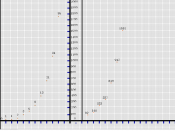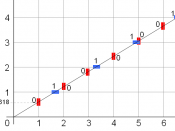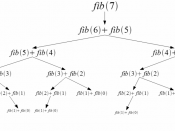Its a good essay, for a Math project. Well don, although you could have had more specific examples.
The Fibonacci numbers were first discovered by a man named Leonardo
Pisano. He was known by his nickname, Fibonacci. The Fibonacci sequence is a
sequence in which each term is the sum of the 2 numbers preceding it. The first 10
Fibonacci numbers are: (1, 1, 2, 3, 5, 8, 13, 21, 34, 55, 89). These numbers are
obviously recursive.
Fibonacci was born around 1170 in Italy, and he died around 1240 in Italy.
He played an important role in reviving ancient mathematics and made significant
contributions of his own. Even though he was born in Italy he was educated in
North Africa where his father held a diplomatic post. He did a lot of traveling with
his father. He published a book called Liber abaci, in 1202, after his return to Italy.
This book was the first time the Fibonacci numbers had been discussed. It was
based on bits of Arithmetic and Algebra that Fibonacci had accumulated during his
travels with his father. Liber abaci introduced the Hindu-Arabic place-valued
decimal system and the use of Arabic numerals into Europe. This book, though,
was somewhat contraversial because it contradicted and even proved some of the
foremost Roman and Grecian Mathematicians of the time to be false. He published
many famous mathematical books. Some of them were Practica geometriae in
1220 and Liber quadratorum in 1225.
The Fibonacci sequence is also used in the Pascal trianle.
The sum of each diagnal row is a
fibonacci number. They are also in the right sequence: 1,1,2,5,8.........
Fibonacci sequence has been a big factor in many patterns of things in nature.
One has found that the fractions u/v representing the screw-like arrangement of
leaves quite often...


